Ask any designer, strategist, or developer, and they’ll all agree on one thing: never overlook the user experience. That’s because if your product isn’t an amazing experience, people won’t want it—especially in cutthroat industries!
A user experience in a digital space is made up of many factors, like research, information architecture, and content. But there’s one overarching concept: UX strategy.
If you want to craft an outstanding user experience for your digital product, you have come to the right place. This article is your UX design strategy guide. Here you’ll learn all about what a UX strategy is, how to create one, the risks, and the top tips you need to use.
What is a UX strategy (and its purpose)?
UX strategy, or user experience strategy, is a methodical approach to planning that looks at both the user and business needs. It links each customer touchpoint to the experience that the company wishes to provide.
Essentially, a UX design strategy is situated at the point where UX design meets business strategy, user needs, and technical capabilities.
![What is a UX Design Strategy? [+ 5 Steps to Make One] 16 What is a UX strategy](https://www.visily.ai/wp-content/uploads/2024/01/What-is-a-UX-strategy-1024x673.jpg)
A UX strategy enables companies to rationally prioritize tasks and guarantees that they don’t devote their resources to unnecessary ones. Developing a UX plan can facilitate the delivery of a product with the necessary features on schedule and within budget, so you can match customers’ requirements with your own preconceived notions of the product.
An effective UX strategy program should consider:
- The existing circumstances of the venture
- Devise a vision for the user experience
- Structure a priority plan to meet objectives
- Decide what UX key performance indicators and metrics to employ to track progress
Visily is a team of product designers. This means we understand UX design principles and good visual skills, as well as product strategy, customer needs, and business objectives.
Why is a UX strategy important?
A good UX strategy helps a product team solve the right problem for target users. If you develop a UX strategy, you may see many other benefits, like:
- It helps to get executives on board: A UX strategy shows how design can help the business meet its goals. This makes leadership more likely to support what you’re doing.
- It brings together business goals, user needs, and technological capabilities: This helps decide what needs to be done and how much time and resources to spend on each item.
- It provides measurable indicators of success: If you know what success looks like and how to measure it, it’s easier to know whether design decisions are helping or hurting the product.
- It puts the user at the forefront (and a culture that follows this principle): Validated user research helps the UX team understand the user better, including their pain points and goals.
- It connects all touchpoints: UX strategy encourages you to take a step back and evaluate all the ways a person can interact with your product or brand.
Four tenets of UX strategy
In Jaime Levy’s “UX Strategy: How to Devise Innovative Digital Products That People Want” (2015), four main principles are outlined to help create successful strategies. According to this book, these components must work together to produce a successful plan.
![What is a UX Design Strategy? [+ 5 Steps to Make One] 17 The 4 tenants of UX strategy](https://www.visily.ai/wp-content/uploads/2024/01/The-4-tenants-of-UX-strategy-1024x673.jpg)
1. Business strategy
These are the company’s guiding principles, as well as competitive advantage, revenue streams, and high-level business objectives.
2. Value innovation
Organizations can create value innovation by striving to provide customers with something distinctive (differentiation) while simultaneously cutting costs.
3. Validated user research
Rather than presuming what is meaningful to a customer, have direct feedback from your potential users before beginning a design. This will protect designers and firms from investing time, money, and energy into a product that nobody desires.
4. Killer user experience design
Once all the other tenants are established, it’s time to create an outstanding user experience centered around the crucial elements of the product. This experience shouldn’t only give the customer something of value, but do so smoothly.
Risks of having a bad (or no) UX strategy process
Organizations often overlook it, but a bad UX strategy carries a genuine danger. No doubt, visuals, and aesthetics are key considerations in planning a digital product, but failing to take into account the user experience can have serious repercussions.
1. Revenue loss and high bounce rates
When users become frustrated with a complex website or an application with intrusive pop-ups, they’ll never return. This is even more true in this “age of the user” since they probably have more options to choose from.
A high bounce rate can cause conversion rates to drop, resulting in lower potential income and hampering business development.
For example, Apple Music has a confusing navigation system and unresponsive components, making it difficult for users to use. This includes things like no auto-complete prompts, global back button, non-interactive pieces, sluggish page shifts, and no recollection of the user’s past session.
![What is a UX Design Strategy? [+ 5 Steps to Make One] 18 Apple Search Music Bar](https://www.visily.ai/wp-content/uploads/2024/01/Apple-Search-Music-Bar-1024x720.jpeg)
The UX challenges make the user’s music search more difficult. This can make the user annoyed and stop using the app.
One way you can combat this is by using product insights and customer insights. You can even use user personas to check if your product is hitting the right marks and not leaving your users frustrated (more on this secret weapon later).
2. Bad UX can damage your SEO
40% of people will abandon a website if it is slow to load. Google has been steadily including user experience metrics in their search engine algorithms because, as they say, “users demonstrate that they favor websites with a fantastic page experience.”
In 2020, Google released a new update for website pages that highlights user experience metrics like loading speed, interactive time, and other elements.
Google prefers websites that offer a pleasant user experience. Make sure yours fits that description with a strong UX strategy, or you’ll notice your rankings take a dip or struggle to rise.
3. Bad UX hurts your brand reputation
We’ve all been there before. A website that’s difficult to use can be extremely irritating for a user.
One way to express dissatisfaction with a brand? Sharing your experience with others.
Research has revealed that people are much more likely to express their dissatisfaction with something than to express their satisfaction with it. Around 13% of people will share with at least fifteen others about an unsatisfactory experience they had while using a brand’s website or app.
Building brand equity can take a while, but a badly designed website with no solid UX strategy can ruin it in an instant.
How to create a UX strategy in 5 steps
Most UX designers adhere to a specific order of steps when devising a UX strategy.
1. Assess the current state of the product and business
A UX designer should start preparing a strategy by assessing the product and the business goals.
Now we know as a UX designer, you’re often putting the focus more on the user (and rightfully so!), but here it bodes well to get some good baseline information about the business. This counts if you are with the business full-time, part-time, or just for one project.
A good place to start is by examining the business plan, vision, or mission. Even if you don’t have a business plan, you still need to get information from stakeholders through interviews. You should ask them questions like:
- What is the market position of the product you are creating?
- What are the main aims and ambitions of the company?
- What criteria are they using to evaluate the effectiveness of the product?
- What does a successful experience for our users look like?
- What do we need to know about them to make sure we are providing a good experience?
- What goals do we need to accomplish financially to make this a success?
- What resources do we have at our disposal to do so?
Other than that, you’ll want to note the issues they know about, like a rise in user churn and a lack of growth in annual recurring revenue.
Then take a good look at the product and how it currently aligns with the business strategy.
2. Find your competitive advantage or how to create one (with research)
Once you understand how to make your design adhere to the company’s brand and plan, you can then evaluate where the product stands among its competitors.
To get people to use your product, you must provide something valuable, after all.
What’ll be the source of that value? What gives you the edge?
This is the place where you must look at businesses that offer similar products or the ones your stakeholders consider rivals. Look at the services they provide, how their products work, and how much user engagement they have. Examine what’s successful and what isn’t.
Investigating your competitors can tell you what your customers want and which tactics to use or ditch.
Another part of finding your competitive advantage is user research. Knowing your users’ demographics, wants and needs is key to making a successful product. Think about what you know about your users, what data you need, and how you’ll get it.
Plan how you’ll distribute questionnaires, surveys, and interviews. Think of ways to communicate the data by using user personas, user flows, and user stories or scenarios.
2.1 Build product insights from your research (secret sauce!)
Another benefit of using user research is that you can often gather product insights. Product insights can help you get an inside look at the problems or pains that current customers of a certain product have.
With this knowledge, you can figure out how to appeal to your customers by solving those points or problems with an innovative solution.
For example, Visily was able to help designers, non-designers, and product managers create designs, wireframes, and prototypes within minutes. Previously, this might have taken them hours (or sometimes painful days!), but with our easy-to-use system and AI, they can do it with minimal steps.
![What is a UX Design Strategy? [+ 5 Steps to Make One] 19 screenshot to design](https://www.visily.ai/wp-content/uploads/2023/10/s2d-min-1024x781.png)
Having to use other applications to present or collaborate was another problem that we solved by creating the platform with collaboration and sharing in mind.
A good way to gather product insights at the early stage of your product development process is by using user interviews (about your current product or competitor products). Use these to zoom in on the pain points and turn them into innovations, and you’ll have a stand-out user experience strategy.
3. Brainstorm and ideate
Now that you have a good grasp of what your users require from your product and the resources you have to produce it, it’s time to begin sketching out some designs. When planning this part of your UX approach, study which brainstorming and development techniques you and your team will use to formulate initial drafts.
Ask your team (and yourself) some questions:
- Which ideation techniques will you employ?
- Do you want to begin with the traditional pen and paper? What design programs do you have access to?
- Is your team in need of a software platform that facilitates remote work?
- What tools will you be using for wireflows and prototyping?
It’s worth noting that you can do all of these in Visily, while most other apps will only facilitate one or two. You can even turn your hand-drawn sketches into designs with Visily and ideate as many designs as you want.
![What is a UX Design Strategy? [+ 5 Steps to Make One] 20 Visily's sketch to design AI feature](https://www.visily.ai/wp-content/uploads/2024/01/The-4-tenants-of-UX-strategy-1-1024x673.jpg)
As you develop your designs, consider how to prioritize the needs of your users. Outline specifically which features, elements, images, and content are required to meet the user’s expectations. Additionally, set accessibility and usability rules that are tailored to your target audience.
It might take more than one brainstorming session to come up with a prototype. However, you need to keep company deadlines and resources in mind.
4. Plan how you will test and evaluate
Now that you know how to generate solutions, map out which strategies you will use to assess designs and how to appraise the outcomes.
Test and evaluate methods to help your team assess product performance. Plan your methods carefully.
You should ask yourself these questions about your testing and planning methods:
- How will you go about finding participants for your user testing?
- Will the tests be supervised or not?
- Are you organizing them remotely or in-person?
- What strategies will you use for user and usability testing?
- Do you have the ability to conduct the tests independently, or do you need to bring in an external testing agency?
- Are you looking to gain insights through qualitative or quantitative feedback?
- How will you interpret and present the data?
- Which metrics will you use to determine success?
- Will the results meet the standards of your development team?
When you’ve got a strong idea of how to test and evaluate, it’s time to start thinking of how to use the data obtained to make meaningful improvements to your product.
5. Plan how to iterate
Any UX strategy must include an approach to revising and refining designs based on user feedback. The UX design process is typically done many times over, even after the product is released to the market.
Plan how you’ll use data from user testing to improve the user experience and maintain the product. This will save you time and effort in the future, as it’ll help you avoid having to do full re-designs.
Tips for creating a UX strategy
Let’s now go over some pro tips that’ll help you build a better UX strategy.
Review data and qualitative findings
Analyzing data related to product usage can be beneficial in determining which features should be prioritized on the roadmap. Don’t just depend on the numbers. Qualitative data can assist you in identifying possible areas of gratification.
Stay focused on your users
User-centric design is essential. A key component of your UX plan should be to identify your primary persona, which will help you to create a design tailored to the user’s needs.
Connect the dots
Work alongside research, project management, sales, support, and other groups to gain a thorough understanding of the company and your customers. Try to get a holistic view of each department’s role and goals and align your outputs with them.
Use Visily to implement your UX strategy
A well-planned UX design strategy can make or break your product. With the right UX tools and by working hard, you can achieve anything you want. Start by developing a strategy and working with your team to make sure it’s done right.
Use Visily for the ideation, collaboration, design, wireframing and prototyping stages. It can help you cut right to chase.
Sign up for your 7 day free trial.
![What is a UX Design Strategy_ [+ 5 Steps to Make One]](https://www.visily.ai/wp-content/uploads/2024/01/What-is-a-UX-Design-Strategy_-5-Steps-to-Make-One-scaled.jpg)








